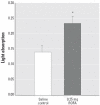Systemic microvascular dysfunction and inflammation after pulmonary particulate matter exposure
- PMID: 16507465
- PMCID: PMC1392236
- DOI: 10.1289/ehp.8413
Systemic microvascular dysfunction and inflammation after pulmonary particulate matter exposure
Abstract
The epidemiologic association between pulmonary exposure to ambient particulate matter (PM) and cardiovascular dysfunction is well known, but the systemic mechanisms that drive this effect remain unclear. We have previously shown that acute pulmonary exposure to PM impairs or abolishes endothelium-dependent arteriolar dilation in the rat spinotrapezius muscle. The purpose of this study was to further characterize the effect of pulmonary PM exposure on systemic microvascular function and to identify local inflammatory events that may contribute to these effects. Rats were intratracheally instilled with residual oil fly ash (ROFA) or titanium dioxide at 0.1 or 0.25 mg/rat 24 hr before measurement of pulmonary and systemic microvascular responses. In vivo microscopy of the spinotrapezius muscle was used to study systemic arteriolar responses to intraluminal infusion of the Ca2+ ionophore A23187 or iontophoretic abluminal application of the adrenergic agonist phenylephrine (PHE). Leukocyte rolling and adhesion were quantified in venules paired with the studied arterioles. Histologic techniques were used to assess pulmonary inflammation, characterize the adherence of leukocytes to systemic venules, verify the presence of myeloperoxidase (MPO) in the systemic microvascular wall, and quantify systemic microvascular oxidative stress. In the lungs of rats exposed to ROFA or TiO2, changes in some bronchoalveolar lavage markers of inflammation were noted, but an indication of cellular damage was not found. In rats exposed to 0.1 mg ROFA, focal alveolitis was evident, particularly at sites of particle deposition. Exposure to either ROFA or TiO2 caused a dose-dependent impairment of endothelium-dependent arteriolar dilation. However, exposure to these particles did not affect microvascular constriction in response to PHE. ROFA and TiO2 exposure significantly increased leukocyte rolling and adhesion in paired venules, and these cells were positively identified as polymorphonuclear leukocytes (PMNLs). In ROFA- and TiO2-exposed rats, MPO was found in PMNLs adhering to the systemic microvascular wall. Evidence suggests that some of this MPO had been deposited in the microvascular wall. There was also evidence for oxidative stress in the microvascular wall. These results indicate that after PM exposure, the impairment of endothelium-dependent dilation in the systemic microcirculation coincides with PMNL adhesion, MPO deposition, and local oxidative stress. Collectively, these microvascular observations are consistent with events that contribute to the disruption of the control of peripheral resistance and/or cardiac dysfunction associated with PM exposure.
Figures








Similar articles
-
Particulate matter exposure impairs systemic microvascular endothelium-dependent dilation.Environ Health Perspect. 2004 Sep;112(13):1299-306. doi: 10.1289/ehp.7001. Environ Health Perspect. 2004. PMID: 15345343 Free PMC article.
-
Pulmonary particulate matter and systemic microvascular dysfunction.Res Rep Health Eff Inst. 2011 Dec;(164):3-48. Res Rep Health Eff Inst. 2011. PMID: 22329339
-
The spontaneously hypertensive rat as a model of human cardiovascular disease: evidence of exacerbated cardiopulmonary injury and oxidative stress from inhaled emission particulate matter.Toxicol Appl Pharmacol. 2000 May 1;164(3):250-63. doi: 10.1006/taap.2000.8899. Toxicol Appl Pharmacol. 2000. PMID: 10799335
-
Role of Mitochondria in the Redox Signaling Network and Its Outcomes in High Impact Inflammatory Syndromes.Front Endocrinol (Lausanne). 2020 Sep 23;11:568305. doi: 10.3389/fendo.2020.568305. eCollection 2020. Front Endocrinol (Lausanne). 2020. PMID: 33071976 Free PMC article. Review.
-
Biologic effects of oil fly ash.Environ Health Perspect. 2002 Feb;110 Suppl 1(Suppl 1):89-94. doi: 10.1289/ehp.02110s1189. Environ Health Perspect. 2002. PMID: 11834466 Free PMC article. Review.
Cited by
-
Dexamethasone blocks the systemic inflammation of alveolar hypoxia at several sites in the inflammatory cascade.Am J Physiol Heart Circ Physiol. 2012 Jul 15;303(2):H168-77. doi: 10.1152/ajpheart.00106.2012. Epub 2012 May 18. Am J Physiol Heart Circ Physiol. 2012. PMID: 22610172 Free PMC article.
-
In-line filtration reduces severe complications and length of stay on pediatric intensive care unit: a prospective, randomized, controlled trial.Intensive Care Med. 2012 Jun;38(6):1008-16. doi: 10.1007/s00134-012-2539-7. Epub 2012 Apr 12. Intensive Care Med. 2012. PMID: 22527062 Free PMC article. Clinical Trial.
-
In vitro inflammatory effects of hard metal (WC-Co) nanoparticle exposure.Int J Nanomedicine. 2016 Nov 21;11:6195-6206. doi: 10.2147/IJN.S121141. eCollection 2016. Int J Nanomedicine. 2016. PMID: 27920526 Free PMC article.
-
Oxidative stress and the cardiovascular effects of air pollution.Free Radic Biol Med. 2020 May 1;151:69-87. doi: 10.1016/j.freeradbiomed.2020.01.004. Epub 2020 Jan 7. Free Radic Biol Med. 2020. PMID: 31923583 Free PMC article. Review.
-
Acute exposure to air pollution particulate matter aggravates experimental myocardial infarction in mice by potentiating cytokine secretion from lung macrophages.Basic Res Cardiol. 2016 Jul;111(4):44. doi: 10.1007/s00395-016-0562-5. Epub 2016 May 30. Basic Res Cardiol. 2016. PMID: 27240856 Free PMC article.
References
-
- Antonini JM, Roberts JR, Jernigan MR, Yang HM, Ma JY, Clarke RW. Residual oil fly ash increases the susceptibility to infection and severely damages the lungs after pulmonary challenge with a bacterial pathogen. Toxicol Sci. 2002;70:110–119. - PubMed
-
- Bagate K, Meiring JJ, Cassee FR, Borm PJ. The effect of particulate matter on resistance and conductance vessels in the rat. Inhal Toxicol. 2004;16:431–436. - PubMed
-
- Brain JD, Knudson DE, Sorokin SP, Davis MA. Pulmonary distribution of particles given by intratracheal instillation or by aerosol inhalation. Environ Res. 1976;11:13–33. - PubMed
-
- Brook RD, Brook JR, Urch B, Vincent R, Rajagopalan S, Silverman F. Inhalation of fine particulate air pollution and ozone causes acute arterial vasoconstriction in healthy adults. Circulation. 2002;105:1534–1536. - PubMed
Publication types
MeSH terms
Substances
Grants and funding
LinkOut - more resources
Full Text Sources
Research Materials
Miscellaneous

